I’ll be honest: it’s been really exciting to see the media embrace non-binary characters more and more these days. Back in 2014 when I first came out as non-binary, I couldn’t even imagine a day where I tried to explain my identity to my parents, let alone imagine a day when such characters started to casually appear in the media. Now, I’m out to friends, to family, and in the workplace, and there are more non-binary characters in the media than ever.
That’s why I want to start out by saying some non-binary representation is better than none. I feel like most marginalized people feel that way. However, marginalized people also do not have to settle for scraps; we are allowed to be critical of portrayals of us in the media. And there’s something interesting happening with non-binary representation that I’ve noticed these past few years, but I don’t see it talked about much outside of my close circle of friends.
I’ve been calling it the Inhuman Non-Binary, and the problem is just what you might expect: a lot of these non-binary characters, especially in genres of science fiction and fantasy, end up being non-human species. While it would make perfect sense that non-human species wouldn’t necessarily default to a binary gender structure like we do, the problem arises when the only non-binary characters in the show, book, video game, or what have you are these non-human species.
The Recurring Theme of Inhuman Non-Binary Characters
To understand the pattern I’m talking about, we need to take a look at some specific examples across a variety of mediums. With the help of some trusted friends, I’ve compiled a (non-exhaustive) list of characters that fall into the Inhuman Non-Binary trope so that you can see just how prevalent this pattern is in fiction.
The J’naii (Star Trek: The Next Generation, 1987)
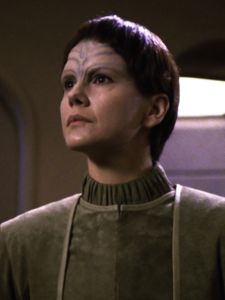 In 1992, an episode of Star Trek: The Next Generation called “The Outcast” aired. In it, the crew of The Enterprise are contacted by an alien race called J’naii. They are an alien race of people who have no gender and who believe any expression of a binary male/female gender is primitive and a kind of sexual perversion.
In 1992, an episode of Star Trek: The Next Generation called “The Outcast” aired. In it, the crew of The Enterprise are contacted by an alien race called J’naii. They are an alien race of people who have no gender and who believe any expression of a binary male/female gender is primitive and a kind of sexual perversion.
I feel like I don’t have to explain too much about this one. They’re agender aliens. NEXT.
All of the Angels and Demons (Good Omens, 1990)
 Good Omens is the lauded and immensely popular novel by Neil Gaiman and Terry Pratchett, which was also recently adapted into an Amazon Prime exclusive TV show starring David Tennant and Michael Sheen. Both the book and the show follow the story of Aziraphale, an angel, and Crowley, a demon, as they team up to stop the approaching Armageddon.
Good Omens is the lauded and immensely popular novel by Neil Gaiman and Terry Pratchett, which was also recently adapted into an Amazon Prime exclusive TV show starring David Tennant and Michael Sheen. Both the book and the show follow the story of Aziraphale, an angel, and Crowley, a demon, as they team up to stop the approaching Armageddon.
Neil Gaiman himself has repeatedly said that he considers ALL of the angels and demons (as well as one of the Four Horsepeople of the Apocalypse) to be non-binary. This makes sense, of course, as even the Bible says that angels have no gender.
Blanca (Animal Crossing, 2001)
 Anyone who’s anyone has likely heard of Animal Crossing at this point, what with how popular the latest release New Horizons has been, especially when it comes to coping with all of the horrors that have come with 2020. This is a video game where you are a human living in a town populated with adorable animal villagers with whom you interact as you go about your day-to-day.
Anyone who’s anyone has likely heard of Animal Crossing at this point, what with how popular the latest release New Horizons has been, especially when it comes to coping with all of the horrors that have come with 2020. This is a video game where you are a human living in a town populated with adorable animal villagers with whom you interact as you go about your day-to-day.
However, not all villagers show up in all games, and there is one particular villager who does not appear in New Horizons: Blanca. Blanca is a peculiar, pure-white cat—but what sets them apart is the fact that they have no face.
Interestingly, Blanca’s gender is noted to be “variable”, as they are listed as male in the original Japanese games but are listed as female in all international localizations. Additionally, regardless of listed gender, Blanca has a lazy/jock voice, both of which are typically male personality types.
BMO (Adventure Time, 2010)
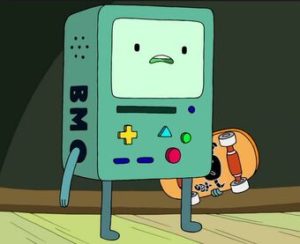 Adventure Time is an animated show that ran on Cartoon Network from 2010 until 2018. Created by Pendleton Ward, it follows the story of a boy named Finn and his best friend, a shapeshifting dog named Jake, who live in a post-apocalyptic place called the Land of Ooo. They go on all sorts of adventures together and interact with a very colorful cast of characters (literally) such as Princess Bubblegum, Marceline the Vampire Queen, The Ice Wizard, The Flame Princess, and more.
Adventure Time is an animated show that ran on Cartoon Network from 2010 until 2018. Created by Pendleton Ward, it follows the story of a boy named Finn and his best friend, a shapeshifting dog named Jake, who live in a post-apocalyptic place called the Land of Ooo. They go on all sorts of adventures together and interact with a very colorful cast of characters (literally) such as Princess Bubblegum, Marceline the Vampire Queen, The Ice Wizard, The Flame Princess, and more.
One such character is BMO, a sentient video game console. Though Ward has never confirmed BMO is non-binary, the show hints at this in a variety of ways: he/him pronouns are used most often for BMO (though the character character Charlie has referred to BMO as “she”), but more feminine terminology such as “m’lady” has been used as well. Additionally, in the gender-swapped episode “Fionna and Cake,” BMO is the only character who has no character differences aside from the shape of his controller.
Zer0 the Assassin (Borderlands 2, 2012)
 Upon its release, Borderlands 2 became praised as one of the best sequels of all time. This is a video game set on the lawless planet of Pandora where people known as Vault Hunters search the planet for mysterious alien vaults, which are said to hold immense treasure. In these games, you get to choose one out of four (or more, in DLC cases) Vault Hunters to play as as you go searching Pandora for wealth and glory.
Upon its release, Borderlands 2 became praised as one of the best sequels of all time. This is a video game set on the lawless planet of Pandora where people known as Vault Hunters search the planet for mysterious alien vaults, which are said to hold immense treasure. In these games, you get to choose one out of four (or more, in DLC cases) Vault Hunters to play as as you go searching Pandora for wealth and glory.
In Borderlands 2, one of these Vault Hunters is named Zer0 the Assassin. Everything about Zer0 from his origins to his gender is left purposefully ambiguous. However, writer Anthony Burch has said in various Q&As, particularly on Ask.fm, that Zer0 was always meant to be genderless or non-binary.
That’s all very exciting… except for the fact that Zer0 falls into both of the criteria of the Inhuman Non-Binary. Zer0 is largely speculated to be either 1) an alien or 2) a robot for myriad reasons. He speaks only in haiku, he’s able to project emojis from his face plate to express emotion, and he only has four digits on his hands.
Additionally, he wears a helmet, featuring (by default) a flat black screen. If he’s an alien, he’s not human. If he’s a robot, he’s not human. And even if by some slim chance he IS human, his head is still completely covered by his helmet; we never once see his face.
All of the Gems (Steven Universe, 2013)
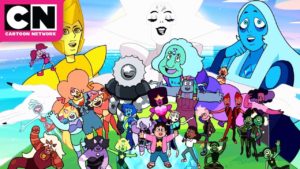 Steven Universe was a show on Cartoon Network that ran from 2013 until 2019. It follows the story of Steven, a half-human, half-alien boy who is in the care of his mother’s friends, all of whom are a type of alien known as gems. They’re just what you would imagine: they are a race of aliens based off of various types of gemstones from rubies to pearls to amethysts and so on.
Steven Universe was a show on Cartoon Network that ran from 2013 until 2019. It follows the story of Steven, a half-human, half-alien boy who is in the care of his mother’s friends, all of whom are a type of alien known as gems. They’re just what you would imagine: they are a race of aliens based off of various types of gemstones from rubies to pearls to amethysts and so on.
Creator Rebecca Sugar has said in various interviews that all of the gems are non-binary and use she/her pronouns. I’ll admit, it’s difficult for me to come down hard on Steven Universe because Sugar is non-binary herself. Non-binary people are allowed explore our identity in fiction however we want, using whatever characters we want.
However, I still thought it was worth noting that in spite of Sugar’s identity, the only non-binary characters in the show ARE non-human.
Janet (The Good Place, 2016)
 The Good Place is easily one of the best sitcoms in recent memory. It follows the story of Eleanor Shellstrop, a woman of shitty character who has died and discovered that she has gone to the good place—except all the details about her are wrong. Apparently, they’ve got the wrong Eleanor Shellstrop, and she’s not supposed to be there.
The Good Place is easily one of the best sitcoms in recent memory. It follows the story of Eleanor Shellstrop, a woman of shitty character who has died and discovered that she has gone to the good place—except all the details about her are wrong. Apparently, they’ve got the wrong Eleanor Shellstrop, and she’s not supposed to be there.
One of the main characters of The Good Place is named Janet, and she is essentially a walking, talking encyclopedia of all knowledge of the universe. Janets are extremely powerful, as they are able to shape and manipulate the neighborhoods the dearly departed live in, and even though they appear human, they are not human.
Janet herself repeatedly corrects other characters about her gender, telling them she’s “not a girl”.
Bastion (Overwatch, 2016)
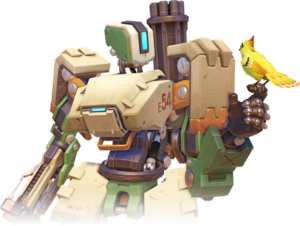 Overwatch is a team-based, first-person shooter game originally released in 2016. Set in a not-so-distant future, you play on a team of six against another team of six and select one of the game’s many heroes to play as. Each hero has different skills and abilities that are integral to winning the match.
Overwatch is a team-based, first-person shooter game originally released in 2016. Set in a not-so-distant future, you play on a team of six against another team of six and select one of the game’s many heroes to play as. Each hero has different skills and abilities that are integral to winning the match.
One of these heroes is a robot named Bastion. Bastion was once a robot that did harm to humans, but after being rebooted, Bastion has gained some sentience and now has a childlike curiosity about the world around it. It’s important to note that Bastion is referred to exclusively with it/its pronouns on the Overwatch website–and it is the ONLY robot character referenced in this way.
Kazi (The Dragon Prince, 2018)
 The Dragon Prince is an animated show on Netflix that began airing in 2018. It’s a fantasy show set in the land of Xadia where there are six primary sources of magic. Humans are trying to create a seventh source, Dark Magic, and the show follows two princes and an assassin as they try to end a war and restore peace to the world.
The Dragon Prince is an animated show on Netflix that began airing in 2018. It’s a fantasy show set in the land of Xadia where there are six primary sources of magic. Humans are trying to create a seventh source, Dark Magic, and the show follows two princes and an assassin as they try to end a war and restore peace to the world.
Now, I’ll admit, I haven’t watched The Dragon Prince yet, but I had some friends recommend the character Kazi to me for this article. According to the show’s Fandom Wiki, Kazi is something called a Sunfire Elf; though mostly humanoid in appearance, Kazi has long, pointed ears and horns bending back from their hairline.
They are referred using only they/them pronouns.
Double Trouble (She-Ra and the Princesses of Power, 2018)
 Originally released on Netflix in 2018, She-Ra and the Princesses of Power is a remake based off of the 1985 cartoon She-Ra: Princess of Power. The new remake follows the story of a girl Adora, a soldier posted on a planet known as Etheria, as she discovers a large sword that gives her the ability to transform into She-Ra, an eight foot tall woman of incredible strength and power.
Originally released on Netflix in 2018, She-Ra and the Princesses of Power is a remake based off of the 1985 cartoon She-Ra: Princess of Power. The new remake follows the story of a girl Adora, a soldier posted on a planet known as Etheria, as she discovers a large sword that gives her the ability to transform into She-Ra, an eight foot tall woman of incredible strength and power.
Again, it’s hard for me to come down too hard on showrunner Noelle Stevenson because Stevenson herself is a lesbian and goes by any pronouns. However, although the show is rife with beautiful LGBTQ+ representation, the only confirmed non-binary character is a shape-shifting alien named Double Trouble who uses they/them pronouns.
Bloodhound (Apex Legends, 2019)
 Apex Legends is a free-to-play battle royale game where squads of three players are dropped into an arena to fight other squads until only one is left standing. You can choose between a variety of characters, called Legends, to play as, and similarly to Overwatch, each character has unique skills and abilities that will help you win the match.
Apex Legends is a free-to-play battle royale game where squads of three players are dropped into an arena to fight other squads until only one is left standing. You can choose between a variety of characters, called Legends, to play as, and similarly to Overwatch, each character has unique skills and abilities that will help you win the match.
One of these Legends is named Bloodhound, a technological tracker whose abilities all focus on finding their enemies and enhancing their skills in order to make themself into the ultimate predator. They are referred using only they/them pronouns on the official Apex Legends website, and multiple members of the game development team have confirmed this is because they’re non-binary.
Why is this a bad thing? Because they sort of have a gimmick similar to Zer0 going on: they’re shrouded in mystery and rumor, which means one key thing: their face remains completely covered by a mask at all times.
Danny Street (Doom Patrol, 2019)
 In 2019, a new superhero show called Doom Patrol began airing on HBO. Based on the DC Comics of the same name, the show follows a ragtag team of people who all have superhuman abilities. The thing is, they all got their abilities through terrible accidents that left them scarred and disfigured.
In 2019, a new superhero show called Doom Patrol began airing on HBO. Based on the DC Comics of the same name, the show follows a ragtag team of people who all have superhuman abilities. The thing is, they all got their abilities through terrible accidents that left them scarred and disfigured.
One of the side characters is called Danny Street, and Danny is… well. Danny’s a street. To quote Larry: “Did I never mention the sentient, teleporting, genderqueer street Vic and I hung out on while Jane lost her shit and tried to get married?” Danny is referred using only they/them pronouns and flies a non-binary flag on their street.
FL4K the Beastmaster (Borderlands 3, 2019)
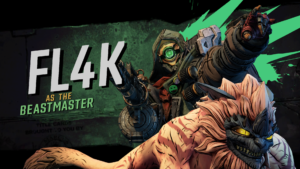 How could I write this article without referencing the one and only FL4K from Borderlands 3?
How could I write this article without referencing the one and only FL4K from Borderlands 3?
Trick question: I COULDN’T! And now it’s their turn.
Borderlands 3 is the sequel to yep, you guessed it, Borderlands 2. And just like Borderlands 2, you get the chance to play as one of four new Vault Hunters hunting across not just Pandora, but the entire universe for Vaults containing hidden secrets, knowledge, and treasure.
FL4K the Beastmaster is one of the four main playable characters. The game developers have confirmed that FL4K is non-binary; they use only they/them pronouns for themself in dialog, and all of the canon lore and text, such as their skill tree, references them with they/them pronouns.
FL4K is also a robot.
Why the Inhuman Non-Binary is a Problem
Continuously seeing minority characters in a certain light or through the lens of a specific trope sends a message to the people who consume that media, regardless of if that message is intentional or not. That’s why certain harmful tropes like Bury Your Gays or Women in Refrigerators can draw such ire from fandom.
Seeing non-binary characters continually relegated to being non-human species says just that: we aren’t human. We’re less than human. Our existences are so unbelievable that a human non-binary character is strange and bizarre.
Also, in many situations, it almost gives the impression that having inhuman non-binary characters or non-binary characters “shrouded in mystery” with their features covered makes it so that content creators don’t have to actually address non-binary identities in any meaningful way.
There’s no reason for characters to discuss identity or have conversations about pronouns. It can be so easily explained away, like, “That’s just the way this fictional culture is,” or “There’s no reason for robots to have gender” (which I agree with, but it’s no substitute for these actual conversations between humans).
It also sometimes makes it feel like the non-binary character is being softened, depending on the fanbase. For example, in video games, it’s no secret that bigotry runs rampant, and cishet men who play video games can be VERY bigoted and believe that any kind of positive diverse representation is “pandering” or the results of “teh SJWs!!!” complaining too much.
Inhuman non-binary characters are more palatable than actual human non-binary characters because those bigoted individuals who may be consuming the media don’t have to think critically about other humans that may be different from them. They don’t have to confront that actual, human non-binary characters exist. We just get to continue being “alien” in their eyes.
How to Humanize Your Non-Binary Characters
This is going to sound pretty obvious, but the best way to humanize your non-binary characters is… to make them human.
And don’t just make them human; make LOTS of them human. Make all sorts of non-binary characters. Non-binary is such a HUGE umbrella that covers a wide variety of identities like agender, bigender, third gender, genderfluid, genderqueer, and on, and on, and on. And not only that, but these genders are expressed in such unique and myriad ways that there is no excuse for any two non-binary characters to be the same.
If you’re not sure how to have human characters discuss gender and identity in a meaningful way, then you need to either bring a non-binary person into your writer’s room or do the research necessary to do right by us.
We’re all just human. And we deserve to see ourselves as such.

